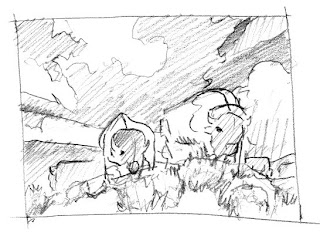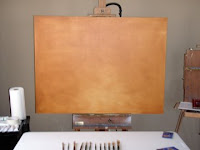
If this sketch is a little too rough for you to make out what is going on, well you're not alone. So to help clear it up a bit; it's a painting of several American Bison standing on a hill, big thunderhead above, sage, grass and rock below. (That's the best I can do, you're just going to have to wait for the 'in progress' painting images I'll be uploading.)
From this point, I collect the reference I will need to begin work on the painting. Here are a few of the images I'll be working from. They were shot in Custer State Park, South Dakota — one of the best places I've ever been to gather reference of bison and pronghorn antelope.



Just in case you're wondering, I use Holbein Artists' Oil Colors, Windsor & Newton Lexington II Flats and Rounds (for this painting, the largest sizes they make), and I'll be painting on 48"x36" stretched linen. Because I’m starting with unprimed linen, I’ll be coating it with four layers of gesso (two coats brushed on vertically, and two coats brushed on horizontally). I coat the linen once in the morning, then again in the evening, and then repeat that process the next day. Once I've finished coating the canvas with gesso (if it needs to be coated at all), I'll let it dry for at least 24 hours before toning it.
 I tone my canvas using a rust color mixed from equal parts Alizarin Crimson, Cadmium Yellow Light, and a dab of Ultramarine Blue (I've already completed toning this substraight). This mixture was thinned using Liquin and applied to the entire surface of the linen. I then rub the entire surface with a paper towel to remove excess paint. I typically let the canvas dry for one day before I begin painting. In this case, it's been drying...for a while.
I tone my canvas using a rust color mixed from equal parts Alizarin Crimson, Cadmium Yellow Light, and a dab of Ultramarine Blue (I've already completed toning this substraight). This mixture was thinned using Liquin and applied to the entire surface of the linen. I then rub the entire surface with a paper towel to remove excess paint. I typically let the canvas dry for one day before I begin painting. In this case, it's been drying...for a while.Please return frequently as I’ll be posting lots of ‘in progress’ shots and I’ll discuss the whys-and-hows of what I’m doing.
